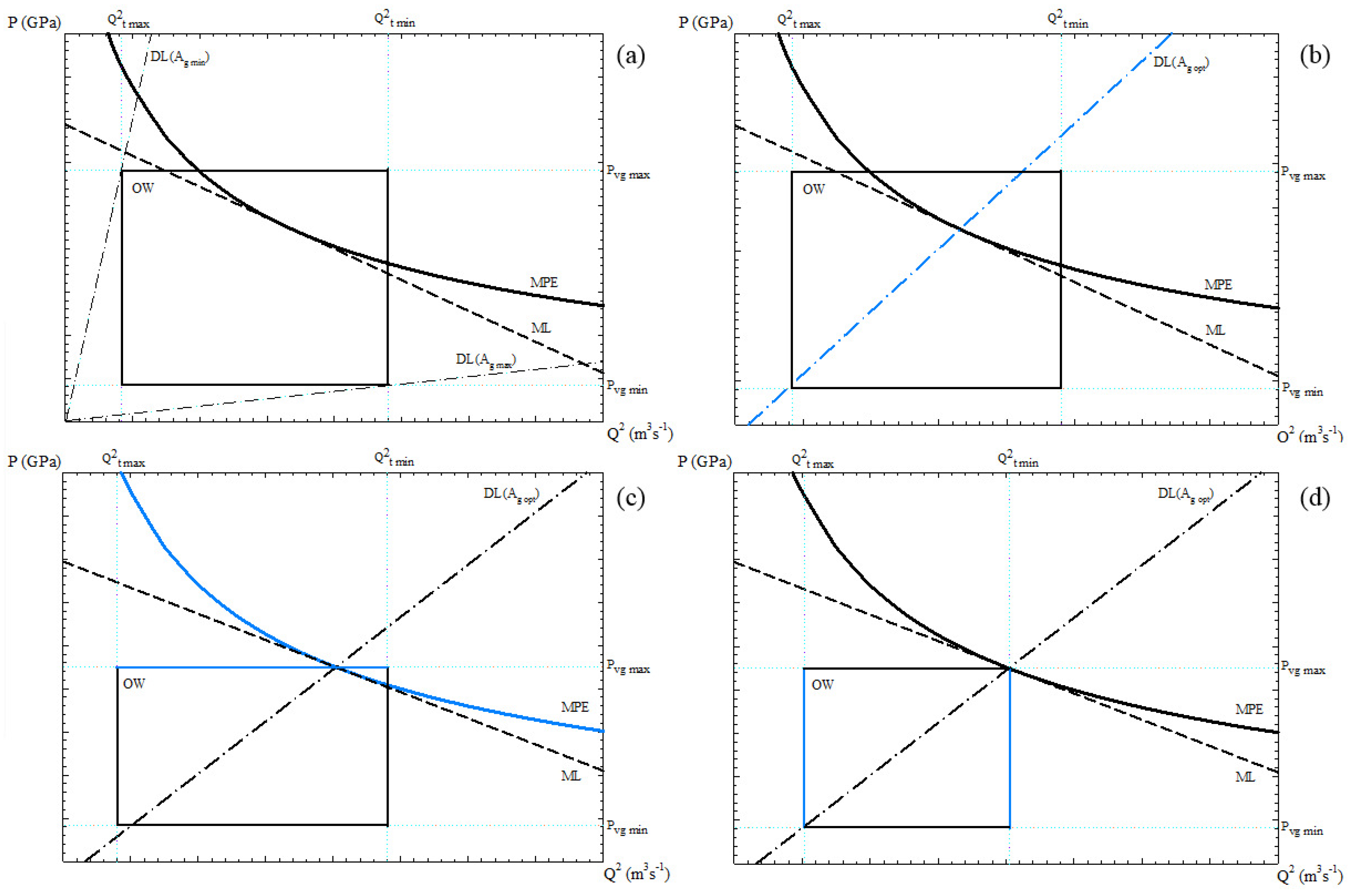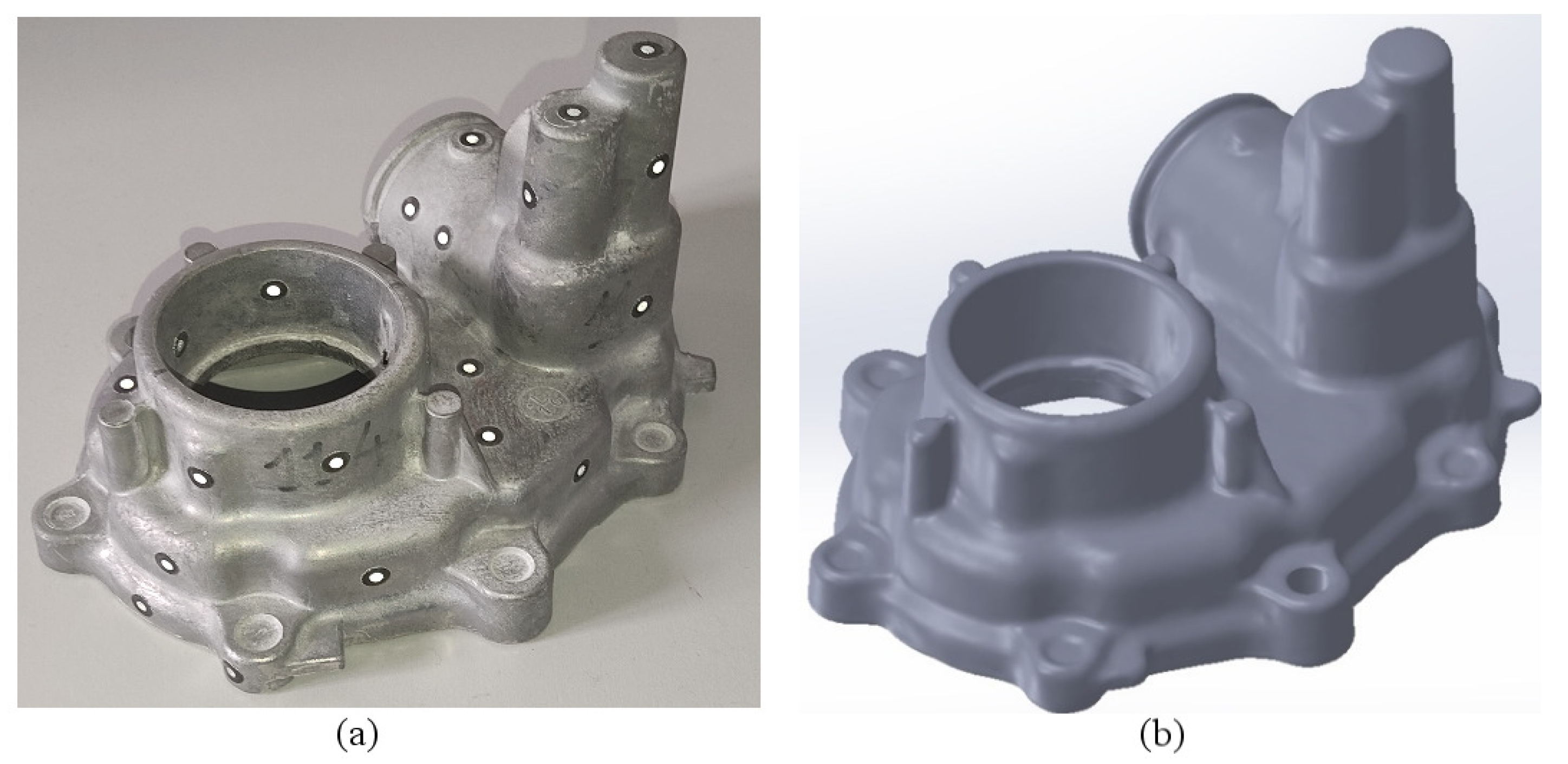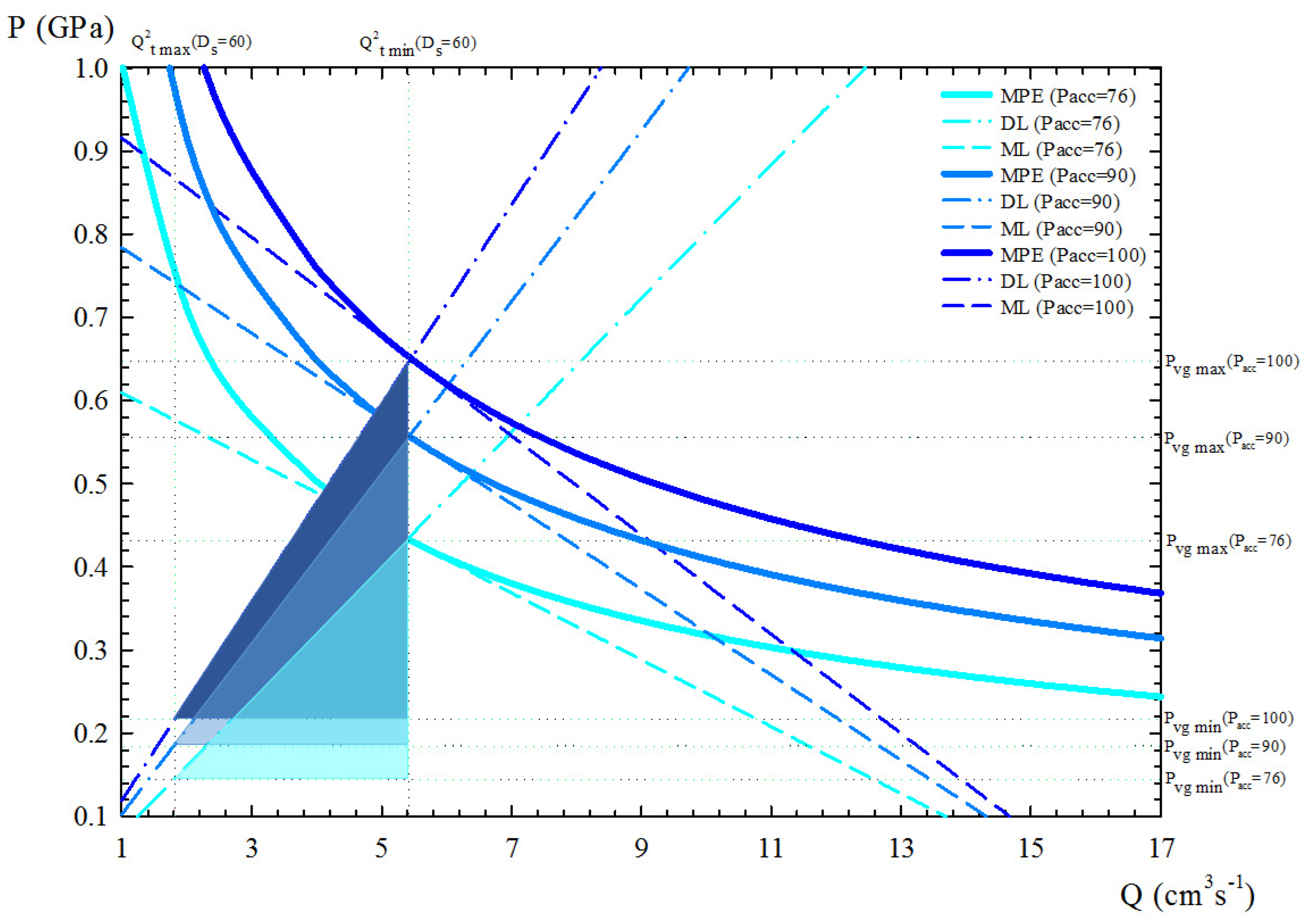A Decision Support System (DSS) for the Prediction and Selection of Optimum Operational Parameters in Pressure Die-Casting Processes
Abstract
:1. Introduction
2. Methodology for the Selection of Operational Parameters in the Pressure Die-Casting Machines
- Inputs: accumulator pressure (); hydraulic loss constant (); hydraulic cylinder diameter (); plunger/shot sleeve diameter (); shot sleeve length (); casting temperature (); liquidus and solidus temperatures (, ); heat of fusion (H); casting heat capacity (); casting density (); minimum gate velocity (); maximum gate velocity (); initial die temperature (); die constant (C); heat transfer coefficient (h); die heat capacity (); die density (); cavity surface area (); cavity volume (); cross-section area of the vent (); vent length ().
- Outputs: plunger velocity profile (); minimum plunger/shot sleeve diameter (); optimum cross-section area of the gate (); minimum cross-section area of the vent (); filling fraction (f); maximum filling fraction (); minimum filling time (); maximum filling time ().
2.1. Optimisation Models Implemented in the DSS
2.1.1. Process Performance:
2.1.2. Product Quality: Determination of the Optimum Shot-Sleeve Velocity Profile
2.1.3. Operational Costs: Determination of the Filling Fraction
2.1.4. Operational Window: Fitting of the Operating Limits
2.2. Procedure for Selection of Operational Parameters: Maximisation of Process Flexibility
- (1)
- The input data are entered into the DSS, and the initial value of and are obtained (Figure 5a).
- (2)
- The available closest to that matches the maximum filling fraction constraint is selected, and new values of , , and are recalculated (Figure 5b).
- (3)
- Increasing the accumulator pressure () below the maximum allowable and fitting the maximum gate velocity () to the intersection point between DL() and ML (Figure 5c).
- (4)
- Increasing the minimum filling time () so that DL() cuts to in the upper right-hand corner (Figure 5d).
- (5)
- Reducing the maximum filling time () or increasing the minimum gate velocity () so that DL() cuts to in the lower left-hand corner (Figure 5d).
3. Management of Inputs and Analysis of Outputs with the DSS
3.1. DSS Workflow
- (1)
- (Data Base): contains all the information of the casting process.
- (2)
- (Calculation Window): performs the calculations to obtain first , then , and finally , from which the optimal values of the output variables (, , , , f, , , and ) are extracted.
- (3)
- (Optimisation Module): takes the optimisation equations to provide optimised values of the input variables ( and ).
3.2. Analysis of Results and Process Optimisation
4. Case Study Employing the DSS
5. Conclusions
Author Contributions
Funding
Institutional Review Board Statement
Informed Consent Statement
Conflicts of Interest
Nomenclature
| First parameter of the plunger acceleration law | |
| A | Measure of the flexibility |
| Surface area of the die cavity | |
| Cross-section area of the gate | |
| Cross-section area of the vent | |
| Second parameter of the plunger acceleration law | |
| C | Casting die constant |
| Heat capacity of the casting material | |
| Heat capacity of the casting die | |
| Plunger/Shot sleeve diameter | |
| f | Fill fraction of casting material in the shot sleeve |
| Initial height of the molten metal in the shot sleeve | |
| h | Heat transfer coefficient at the die cavity surface |
| H | heat of fusion |
| Characteristic constant of the hydraulic system | |
| Length of the shot sleeve | |
| Length of the vent | |
| Pressure exerted by the accumulator to the hydraulic system | |
| Q | Flow rate |
| Casting material density | |
| Die material density | |
| Filling time of the casting material in the die cavity | |
| Initial casting material temperature | |
| Initial die temperature | |
| Liquidus temperature of the casting material | |
| Solidus temperature of the casting material | |
| Gate velocity of casting material | |
| Volume of the die cavity | |
| Distance between plunger and pouring hole | |
| Position of the plunger in shot sleeve | |
| Plunger velocity profile | |
| Plunger acceleration profile | |
| CAE | Computer Aided Engineering |
| CFD | Computational Fluid Dynamics |
| Die Line | |
| DSS | Decision Support System |
| Machine Line | |
| Machine Performance Envelope | |
| NADCA | North American Die Casting Association |
| Operational Window | |
| PCD | Pressure Die Casting |
| VOF | Volume Of Fluid |
References
- Ammen, C. Metalcasting; Craftmaster Series; McGraw-Hill: New York, NY, USA, 1999. [Google Scholar]
- Cao, H.; Luo, Z.; Wang, C.; Wang, J.; Hu, T.; Xiao, L.; Che, J. The Stress Concentration Mechanism of Pores Affecting the Tensile Properties in Vacuum Die Casting Metals. Materials 2020, 13, 3019. [Google Scholar] [CrossRef] [PubMed]
- Campbell, J. Castings, 2nd ed.; Elsevier Butterworth-Heinemann: Oxford, UK, 2003. [Google Scholar] [CrossRef]
- Rajkolhe, R.; Khan, J.G. Defects, causes and their remedies in casting process: A review. Int. J. Res. Advent Technol. 2014, 2, 375–383. [Google Scholar]
- Bonollo, F.; Gramegna, N.; Timelli, G. High-Pressure Die-Casting: Contradictions and Challenges. JOM 2015, 67, 901–908. [Google Scholar] [CrossRef]
- Gašpár, Š.; Majerník, J.; Kolínský, J. Analysis of Causes of Porosity Change of Castings under the Influence of Variable Biscuit Height in the Filling Chamber. Materials 2021, 14, 6827. [Google Scholar] [CrossRef]
- Yang, H.; Guo, Z.; Xiong, S. Microstructure and mechanical properties of high-pressure die cast pure copper. J. Mater. Process. Tech. 2020, 275, 116377. [Google Scholar] [CrossRef]
- Dargusch, M.S.; Dour, G.; Schauer, N.; Dinnis, C.M.; Savage, G. The influence of pressure during solidification of high pressure die cast aluminium telecommunications components. J. Mater. Process. Technol. 2006, 180, 37–43. [Google Scholar] [CrossRef]
- Laws, K.J.; Gun, B.; Ferry, M. Effect of die-casting parameters on the production of high quality bulk metallic glass samples. Mater. Sci. Eng. A 2006, 425, 114–120. [Google Scholar] [CrossRef]
- Wang, L.; Turnley, P.; Savage, G. Gas content in high pressure die castings. J. Mater. Process. Technol. 2011, 211, 1510–1515. [Google Scholar] [CrossRef]
- Lee, S.G.; Gokhale, A.M.; Patel, G.R.; Evans, M. Effect of process parameters on porosity distributions in high-pressure die-cast AM50 Mg-alloy. Mater. Sci. Eng. A 2006, 427, 99–111. [Google Scholar] [CrossRef]
- Zamora, R.; Hernandez-Ortega, J.J.; Faura, F.; Lopez, J.; Hernandez, J. Experimental Investigation of Porosity Formation During the Slow Injection Phase in High-Pressure Die-Casting Processes. J. Manuf. Sci. E-T ASME 2008, 130, 051009. [Google Scholar] [CrossRef]
- Santos, S.L.D.; Antunes, R.A.; Santos, S.F. Influence of injection temperature and pressure on the microstructure, mechanical and corrosion properties of a AlSiCu alloy processed by HPDC. Mater. Des. 2015, 88, 1071–1081. [Google Scholar] [CrossRef]
- Faura, F.; López, J.; Hernández, J. On the optimum plunger acceleration law in the slow shot phase of pressure die casting machines. Int. J. Mach. Tools Manuf. 2001, 41, 173–191. [Google Scholar] [CrossRef]
- López, J.; Faura, F.; Hernández, J.; Gómez, P. On the Critical Plunger Speed and Three-Dimensional Effects in High-Pressure Die Casting Injection Chambers. J. Manuf. Sci. Eng. 2003, 125, 529–537. [Google Scholar] [CrossRef]
- Fiorese, E.; Richiedei, D.; Bonollo, F. Improving the quality of die castings through optimal plunger motion planning: Analytical computation and experimental validation. Int. J. Adv. Manuf. Technol. 2017, 88, 1475–1484. [Google Scholar] [CrossRef]
- Anastasiou, K.S. Optimization of the aluminium die casting process based on the Taguchi method. Proc. Inst. Mech. Eng. Part B J. Eng. Manuf. 2002, 216, 969–977. [Google Scholar] [CrossRef]
- Syrcos, G.P. Die casting process optimization using Taguchi methods. J. Mater. Process. Technol. 2003, 135, 68–74. [Google Scholar] [CrossRef]
- Wu, D.H.; Chang, M.S. Use of Taguchi method to develop a robust design for the magnesium alloy die casting process. Mater. Sci. Eng. A 2004, 379, 366–371. [Google Scholar] [CrossRef]
- Verran, G.O.; Mendes, R.P.K.; Rossi, M.A. Influence of injection parameters on defects formation in die casting Al12Si1,3Cu alloy: Experimental results and numeric simulation. J. Mater. Process. Technol. 2006, 179, 190–195. [Google Scholar] [CrossRef]
- Verran, G.O.; Mendes, R.P.K.; Valentina, L.V.O.D. DOE applied to optimization of aluminum alloy die castings. J. Mater. Process. Technol. 2008, 200, 120–125. [Google Scholar] [CrossRef]
- Rathinam, N.; Dhinakaran, R.; Sharath, E. Optimizing process parameters to reduce blowholes in high pressure die casting using Taguchi methodology. Mater. Today Proc. 2021, 38, 2871–2877. [Google Scholar] [CrossRef]
- Sun, Z.; Hu, H.; Chen, X. Numerical optimization of gating system parameters for a magnesium alloy casting with multiple performance characteristics. J. Mater. Process. Technol. 2008, 199, 256–264. [Google Scholar] [CrossRef]
- Khayat, R.E. A three-dimensional boundary element approach to confined free-surface flow as applied to die casting. Eng. Anal. Bound. Elem. 1998, 22, 83–102. [Google Scholar] [CrossRef]
- Barone, M.R.; Caulk, D. New method for analyzing cavity fill in die casting. In Proceedings of the 20th International Die Casting Congress, Cleveland, OH, USA, 1–4 November 1999. [Google Scholar]
- Zhao, H.; Wang, F.; Li, Y.; Xia, W. Experimental and numerical analysis of gas entrapment defects in plate ADC12 die castings. J. Mater. Process. Technol. 2009, 209, 4537–4542. [Google Scholar] [CrossRef]
- Hernández-Ortega, J.J.; Zamora, R.; Palacios, J.; López, J.; Faura, F. An Experimental and Numerical Study of Flow Patterns and Air Entrapment Phenomena During the Filling of a Vertical Die Cavity. J. Manuf. Sci. Eng. 2010, 132, 051011. [Google Scholar] [CrossRef]
- Hu, B.H.; Tong, K.K.; Niu, X.P.; Pinwill, I. Design and optimisation of runner and gating systems for the die casting of thin-walled magnesium telecommunication parts through numerical simulation. J. Mater. Process. Technol. 2000, 105, 128–133. [Google Scholar] [CrossRef]
- Hernández, J.; López, J.; Faura, F.; Gómez, P. Analysis of the Flow in a High-Pressure Die Casting Injection Chamber. J. Fluids Eng. 2003, 125, 315–324. [Google Scholar] [CrossRef]
- Dou, K.; Lordan, E.; Zhang, Y.; Jacot, A.; Fan, Z. A novel approach to optimize mechanical properties for aluminium alloy in High pressure die casting (HPDC) process combining experiment and modelling. J. Mater. Process. Technol. 2021, 296, 117193. [Google Scholar] [CrossRef]
- Kohlstädt, S.; Vynnycky, M.; Goeke, S.; Gebauer-Teichmann, A. On Determining the Critical Velocity in the Shot Sleeve of a High-Pressure Die Casting Machine Using Open Source CFD. Fluids 2021, 6, 386. [Google Scholar] [CrossRef]
- Qi, S.; Brevick, J. Computer Models for Die Casting Shot Sleeve Simulation; Techreport MF99-133; Society of Manufacturing Engineers: Southfield, MI, USA, 1999. [Google Scholar]
- Kong, L.X.; She, F.H.; Gao, W.M.; Nahavandi, S.; Hodgson, P.D. Integrated optimization system for high pressure die casting processes. J. Manuf. Process. 2008, 201, 629–634. [Google Scholar] [CrossRef]
- Wang, T.; Huang, J.; Fu, H.; Yu, K.; Yao, S. Influence of Process Parameters on Filling and Feeding Capacity during High-Pressure Die-Casting Process. Appl. Sci. 2022, 12, 4757. [Google Scholar] [CrossRef]
- Dou, K.; Lordan, E.; Zhang, Y.J.; Jacot, A.; Fan, Z.Y. A complete computer aided engineering (CAE) modelling and optimization of high pressure die casting (HPDC) process. J. Manuf. Process. 2020, 60, 435–446. [Google Scholar] [CrossRef]
- Jadhav, A.R.; Hujare, D.P.; Hujare, P.P. Design and optimization of gating system, modification of cooling system position and flow simulation for cold chamber high pressure die casting machine. Mater. Today Proc. 2021, 46, 7175–7181. [Google Scholar] [CrossRef]
- Tai, C.C.; Lin, J.C. A runner-optimization design study of a die-casting die. J. Mater. Process. Technol. 1998, 84, 1–12. [Google Scholar] [CrossRef]
- Tai, C.C.; Lin, J.C. The optimal position for the injection gate of a die-casting die. J. Mater. Process. Technol. 1999, 86, 87–100. [Google Scholar] [CrossRef]
- Yarlagadda, P.K.; Chiang, E.C.W. A neural network system for the prediction of process parameters in pressure die casting. J. Mater. Process. Technol. 1999, 89–90, 583–590. [Google Scholar] [CrossRef]
- Krimpenis, A.; Benardos, P.G.; Vosniakos, G.C.; Koukouvitaki, A. Simulation-based selection of optimum pressure die-casting process parameters using neural nets and genetic algorithms. Int. J. Adv. Manuf. Technol. 2006, 27, 509–517. [Google Scholar] [CrossRef]
- Tsoukalas, V. Optimization of porosity formation in AlSi9Cu3 pressure die castings using genetic algorithm analysis. Mater. Des. 2008, 29, 2027–2033. [Google Scholar] [CrossRef]
- Rai, J.K.; Lajimi, A.M.; Xirouchakis, P. An intelligent system for predicting HPDC process variables in interactive environment. J. Mater. Process. Technol. 2008, 203, 72–79. [Google Scholar] [CrossRef]
- Pandya, K.V. Review of modelling techniques and tools for decision making in manufacturing management. IEE Proc.-Sci. Meas. Technol. 1995, 142, 371–377. [Google Scholar] [CrossRef]
- Giachetti, R.E. A decision support system for material and manufacturing process selection. J. Intell. Manuf. 1998, 9, 265–276. [Google Scholar] [CrossRef]
- Al-Ahmari, A.; Ridgway, K. An integrated modelling method to support manufacturing systems analysis and design. Comput. Ind. 1999, 38, 225–238. [Google Scholar] [CrossRef]
- Torres, V.H.; Ríos, J.; Vizán, A.; Pérez, J.M. Development to integrate conceptual design tools and a CAD system. In AIP Conference Proceedings; American Institute of Physics: College Park, MD, USA, 2012; Volume 1431, pp. 22–29. [Google Scholar] [CrossRef]
- Faura, F.; Sebastián, M.A.; Zamora, R. A decision support system for sheet metal blanking process parameters selection. J. Mater. Process. Technol. 2001, 118, 371–376. [Google Scholar] [CrossRef]
- Tiwari, M.K.; Banerjee, R. A decision support system for the selection of a casting process using analytic hierarchy process. Prod. Plan. Control 2001, 12, 689–694. [Google Scholar] [CrossRef]
- Wu, S.; Fuh, J.; Lee, K. Semi-automated parametric design of gating systems for die-casting die. Comput. Ind. Eng. 2007, 53, 222–232. [Google Scholar] [CrossRef]
- Karni, Y. Selection of Process Variables for Die Casting. Ph.D. Thesis, The Ohio State University, Columbus, OH, USA, 1991. [Google Scholar]
- Bar-Meir, G.; Eckert, E.R.G.; Goldstein, R.J. Air Venting in Pressure Die Casting. J. Fluids Eng. 1997, 119, 473–476. [Google Scholar] [CrossRef]
- Pego, M. Die Casting Design. A Parametric Approach. Master’s Thesis, Carleton University Ottawa, Ottawa, ON, Canada, 1997. [Google Scholar]
- Herman, E.A. Die Casting Process Control; North America Die Casting Association: Arlington Heights, IL, USA, 2015. [Google Scholar]
- Miller, A. Gating Manual; North America Die Casting Association: Arlington Heights, IL, USA, 2016. [Google Scholar]
- Flemings, M. Solidification Processing; McGraw-Hill Education: New York, NY, USA, 1974. [Google Scholar]









| Si (%) | Fe (%) | Cu (%) | Mg (%) | Mn (%) | Ni (%) | Zn (%) | Sn (%) |
|---|---|---|---|---|---|---|---|
| 11.0–13.00 | 2.0 | 1.0 | 0.1 | 0.35 | 0.5 | 0.5 | 0.15 |
| Casting Material | Casting Die | Casting Machine | Optimisation | ||||
|---|---|---|---|---|---|---|---|
| (C) | 680 | (C) | 260 | (bar) | 90 | (bar) | 76, 90, 100 |
| (C) | 582 | C | 71,593,693 | 1,000,000 | (mm) | 55, 60, 65 | |
| (C) | 574 | h (W/mK) | 4000 | (mm) | 125 | (m/s) | 1.4 |
| (kJ/kgC) | 0.963 | (kJ/kgC) | 0.615 | (mm) | 45, 50, 55, 60, 65, 70 | (m/s) | 3.2 |
| (kg/m) | 2660 | (kg/m) | 7800 | (mm) | 273 | ||
| H (kJ/kg) | 389 | (mm) | 15490.5 | ||||
| (mm) | 256,500 | ||||||
| (mm) | 18 | ||||||
| (mm) | 152 | ||||||
| Soft Variables | Hard Variables | ||
|---|---|---|---|
| (bar) | 100 | (mm) | 60 |
| (s) | 0.112 | (cm) | 7.75 |
| (s) | 0.193 | (mm) | 17.44 |
| Table 4 | f (%) | 39.88 | |
| (%) | 41.02 | ||
| t (s) | X(t) (m) | X(t) (ms) |
|---|---|---|
| 0.000 | 0.000 | 0.0000 |
| 0.056 | 0.001 | 0.0017 |
| 0.112 | 0.004 | 0.0036 |
| 0.168 | 0.009 | 0.0056 |
| 0.224 | 0.018 | 0.0800 |
| 0.280 | 0.030 | 0.1070 |
| 0.336 | 0.046 | 0.1380 |
| 0.392 | 0.069 | 0.1760 |
| 0.448 | 0.101 | 0.2260 |
| 0.504 | 0.149 | 0.2960 |
| 0.560 | 0.257 | 0.4590 |
Publisher’s Note: MDPI stays neutral with regard to jurisdictional claims in published maps and institutional affiliations. |
© 2022 by the authors. Licensee MDPI, Basel, Switzerland. This article is an open access article distributed under the terms and conditions of the Creative Commons Attribution (CC BY) license (https://creativecommons.org/licenses/by/4.0/).
Share and Cite
Martínez-Pastor, J.; Hernández-Ortega, J.J.; Zamora, R. A Decision Support System (DSS) for the Prediction and Selection of Optimum Operational Parameters in Pressure Die-Casting Processes. Materials 2022, 15, 5309. https://doi.org/10.3390/ma15155309
Martínez-Pastor J, Hernández-Ortega JJ, Zamora R. A Decision Support System (DSS) for the Prediction and Selection of Optimum Operational Parameters in Pressure Die-Casting Processes. Materials. 2022; 15(15):5309. https://doi.org/10.3390/ma15155309
Chicago/Turabian StyleMartínez-Pastor, Juan, Juan José Hernández-Ortega, and Rosendo Zamora. 2022. "A Decision Support System (DSS) for the Prediction and Selection of Optimum Operational Parameters in Pressure Die-Casting Processes" Materials 15, no. 15: 5309. https://doi.org/10.3390/ma15155309






